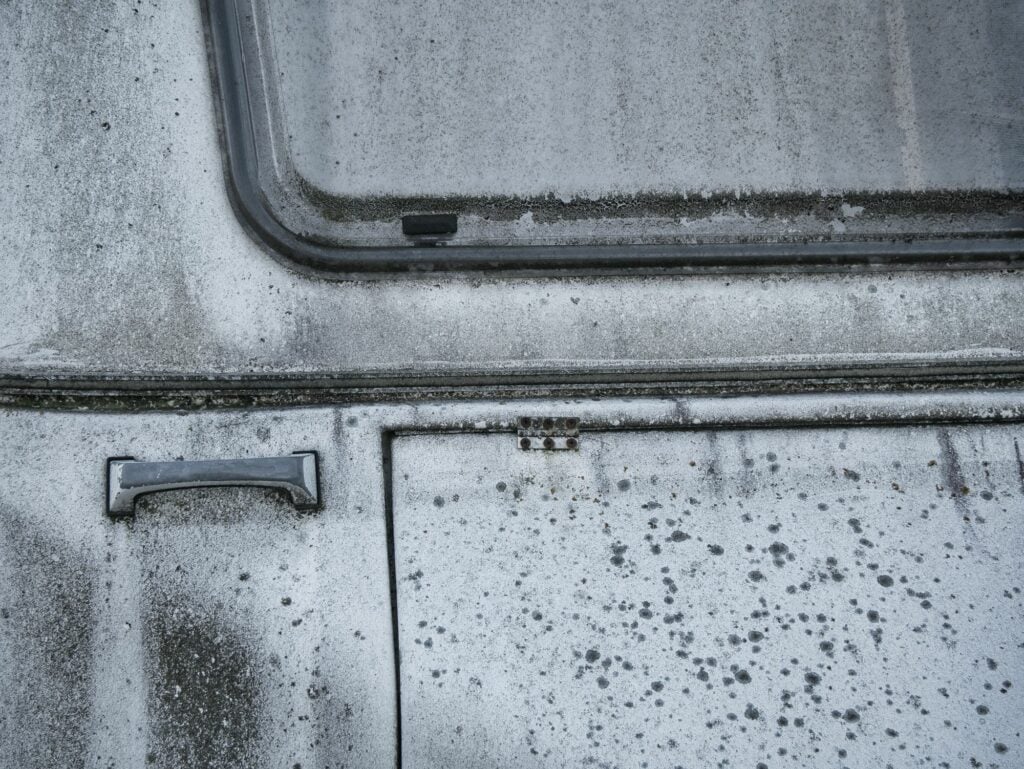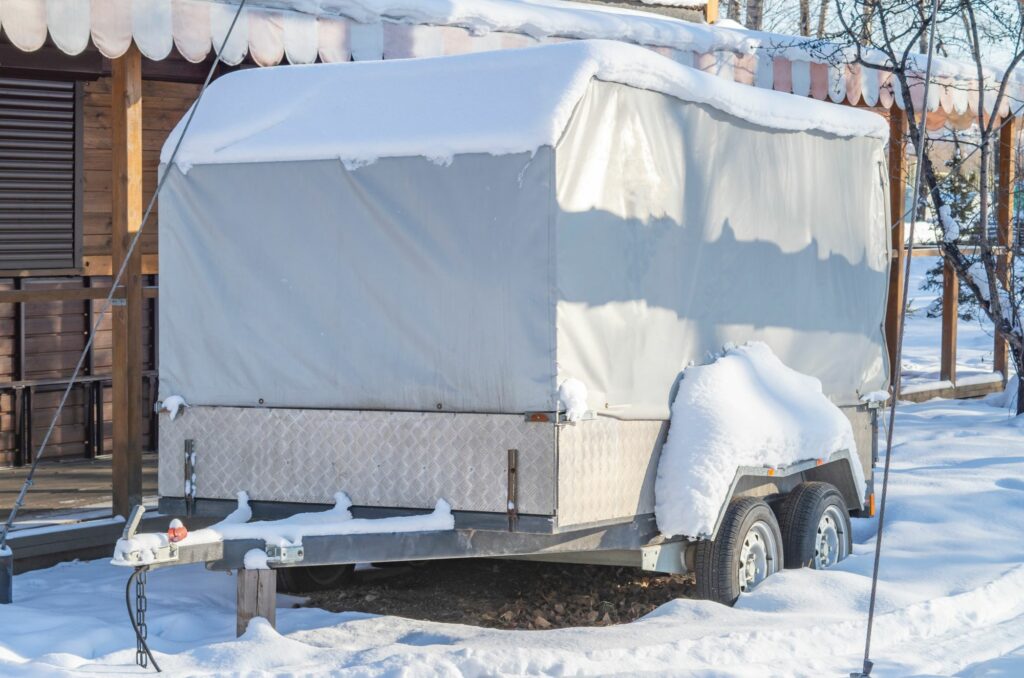Mold growth is a common fear among RVers. Not only does mold decrease the value of your RV, but mold spores also pose a health hazard to those who inhale them and can cause permanent lung damage.
Due to how small RV interiors are (along with their poor air circulation), the likelihood of inhaling mold spores is far higher in an RV than in a traditional home. Perhaps unsuspectingly, RVs are a hotspot for mold growth, specifically in drawers, closets, bathrooms, and kitchens.
The risk of mold only increases when an RV is in storage.
When an RV remains unused for long periods, the air inside RVs stagnates due to poor circulation, breeding a hotbed for moisture. Therefore, it’s important to know how to prevent mold from forming inside a stored RV.
How Does Mold Form?

While most people have heard of mold and understand its dangers, not everyone knows how mold actually forms.
Mold forms when enough mold spores gather together in one place. Mold spores are so tiny that they’re invisible to the naked eye, but they’re present virtually everywhere in the environment.
For mold spores to gather together and drop from the air onto a surface, they need two things – moisture and a lack of air circulation. The lack of circulation and ventilation allows mold spores to land in their desired location, typically on a wet or moist surface.
The spores then feed on the moisture and reproduce, and when enough of them clump together in one place, it results in visible mold. Mold is fairly easy to spot, as it will have a dark green or black color and will become fuzzy when it’s ready to reproduce.
Because mold requires poor air circulation and moisture to grow, stored RVs make an excellent candidate for three reasons.
- When an RV isn’t in use, there’s no air circulation inside the RV.
- Because of the liquids used during winterization and because RVs have internal plumbing systems, it’s highly likely that moisture will form inside your RV.
Why Is It Important to Prevent Mold in an RV?
In addition to being unsightly, mold is also a health hazard. Mold spores can cause permanent lung damage when you inhale them in large amounts. In smaller amounts, while not life-threatening, inhaling mold spores irritates the lungs and causes allergy flare-ups, resulting in coughing fits, a runny nose, headaches, watery eyes, and more.
How to Keep Moisture Out of an RV in Storage
Pre-Storage Inspection and Cleaning
Before putting your RV into storage, it’s important to perform a thorough inspection and deep cleaning of the inside and outside of the rig. Your checklist should include the following tasks:
- Washing and wiping down the outside of your RV.
- Wiping down and drying all the interior surfaces in your RV.
- Use an air compressor to blow out all your water lines and pipes to ensure they’re dry.
Check the RV For Leaks and Cracks
As part of your pre-storage maintenance list, you should check the outside of your RV for any leaks and cracks. This includes checking the slide-outs, roof, roof vents, and exterior walls, as well as around all your doors and windows.
A tiny crack or leak is all that moist air or water vapor needs to infiltrate your RV, rendering your vehicle a feeding ground for mold spores.
Open Your Cabinet Doors and Drawers
Before you leave your RV in its storage location, walk through the rig and open up all your cabinet doors, drawers, storage bins, and closets. By keeping these doors open, the air inside won’t grow stagnant and isn’t at as much risk for mold growth.
Use Dehumidifiers
Another great way to prevent mold and mildew in a stored RV is to keep a high-quality dehumidifier inside. Dehumidifiers remove moisture from the air, which means that mold spores will have nothing to feed on.
Note that while a dehumidifier won’t necessarily kill mold spores that are already present, it will prevent them from reproducing and becoming dangerous.
Keep a Fan Running
In addition to dehumidifiers, it’s also a good idea to keep a fan running inside your RV while it’s in storage. Fans will keep the air circulating and won’t give mold spores a chance to float down and land on moist surfaces if any are present.
You can operate your fan and dehumidifier if your RV storage space has a power source.
Use Moisture Absorbing Packets
While dehumidifiers do a great job of getting rid of excess moisture, they may not be able to reach every corner of your RV. In those corners far out of your dehumidifier’s reach (closed closets, locked cabinets, etc.), you can place moisture-absorbing packets, such as Damp Rid.
Damp Rid containers and packets absorb moisture in the air and help give your RV a fresher, cleaner smell. They’re an excellent option for smaller areas like closets, cabinets, drawers, and storage compartments.
Check In on the RV Regularly
It’s essential to check in on your stored RV at least once per month or bi-weekly to ensure mold isn’t starting to grow.
Regular check-ins are also an excellent way to ensure your fans and dehumidifiers are working and to check the inside air temperature. If it feels too hot or cold, run the air conditioner, RV furnace, or heater to regulate the temperature and minimize the risk of mold growth.
Use an RV Cover For Outdoor Storage
Ideally, it’s best to keep your RV at an indoor, climate-controlled storage facility. However, due to budgetary and location restrictions, this isn’t always possible. Therefore, if you have to store your RV outdoors, RV covers are a great way to keep moisture from infiltrating your rig and forming a feeding ground for mold spores.
For more information on the different types of RV covers, check out this resource.

Final Thoughts
Where you store your RV (when it’s not in use) plays a massive role in whether or not mold can grow inside it. Whenever possible, it’s best to find climate-controlled indoor storage for your RV so that moisture, mold, and mildew are less of a threat.
Consider using Neighbor to find the best enclosed and climatized storage solution for your RV. Neighbor is a peer-to-peer storage marketplace for RVs offering safe, dry, and affordable storage options near you.
Frequently Asked Questions
How to Keep Moisture Out of an RV in Winter?
The best way to keep mold out of a stored RV is to implement a dehumidifier and moisture-removing crystals. It’s also beneficial to keep a fan running inside the RV.
What Is the Importance of Using a High-Quality, Breathable RV Cover for Outdoor Storage?
If you store your RV outdoors, it’s essential to use a breathable RV cover that won’t trap moisture inside your RV.
How Can I Maintain Proper Ventilation and Airflow During RV Storage?
The best way to maintain proper airflow and circulation in a stored RV is to keep fans running constantly. You can also crack open a window or vent (but you’ll need to ensure it’s not in a location where moisture can seep into the interior, first).

